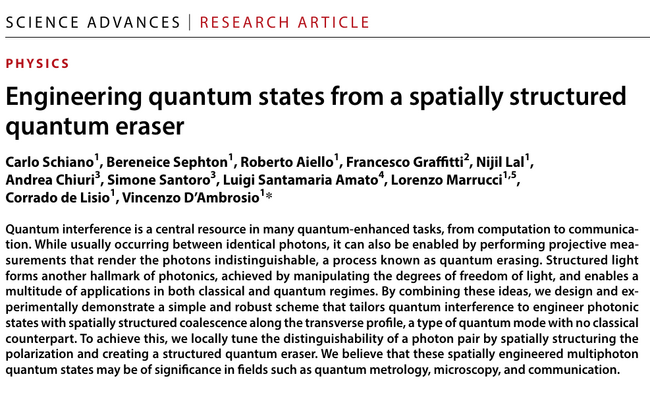This reports on correlations arising from structured light (polarization in vortices) by projective measurements and quantum erasing. Specifically, the polarization is varied in space (structured light) and interferences of two beams with spatially matching or incompatible (perpendicular) states result in bunching or antibunching.
innate dependency of the HOM effect on identical conditions to demonstrate how spatially tailoring a degree of freedom can allow one to spatially tailor quantum interference
It relies heavily on the HOM effect, with a nice set of references on variations to the original (temporal) version (their Refs. 2‒13). In particular, they highlight their extension «to the spatial degree of freedom upon the advent of single-photon cameras [16‒20]». There is also extensive literature on single-photon cameras.
One claim is that:
All degrees of freedom addressed so far in the context of structured light, even in quantum regime, are related to classical light (42)
in the light of which, the Authors claim that they
engineer states that are instead directly structured in a quantum feature of the electromagnetic field (i.e., photonic coalescence) and thus provide a type of structured quantum light without a classical counterpart.
The input is assumed to be Fock (non-Gaussian) states:

although in the experiment, they actually use squeezed states:
Initially, biphotons (λ = 810 nm) generated via spontaneous parametric downconversion (SPDC)
In the above, $n$ refers ultimately to the modes $\in\{\mathrm{rad},\pi\}$. The exact specification of these modes is provided in Eqs. (1-2).
They compute $g^{(2)}$ but call "fourth-order correlation functions" what we would call second-order.
Their characterization is essentially a temporal HOM effect (peak in time), as a function of the angular degree of freedom.
photon bunching is tailored along the optical mode transverse profile so that in each position we can have a zero-or-two photon NOON state (HOM dips), a single photon (HOM peak), or some combination of the two.
They base their control of the process on «photonic coalescence».
such a projection process allows one to edit the state by tuning photon bunching/antibunching behavior, thus lending the quantum eraser to be used as a structuring tool.
Particularly interesting is their use of a bucket detector, which we could include in our theory of photodetection to study the role of the observer:
When tuning the temporal distinguishability, the polarization mixing in the quantum eraser results in a corresponding space-variant distribution of HOM, exhibiting peaks, dips, or flat curves. This takes place despite one photon being detected with a bucket detector.
Other nice summaries of the work, in the words of the Authors:
we demonstrate a scheme to spatially structure the quantum erasing process itself, thus obtaining a photonic state that is directly structured in photonic coalescence. To do this, we harness the innate dependency of the HOM effect on identical conditions to demonstrate how spatially tailoring a degree of freedom can allow one to spatially tailor quantum interference.
we have generated structured quantum states of light that have no classical counterpart, with a spatially tailored bosonic coalescence.
